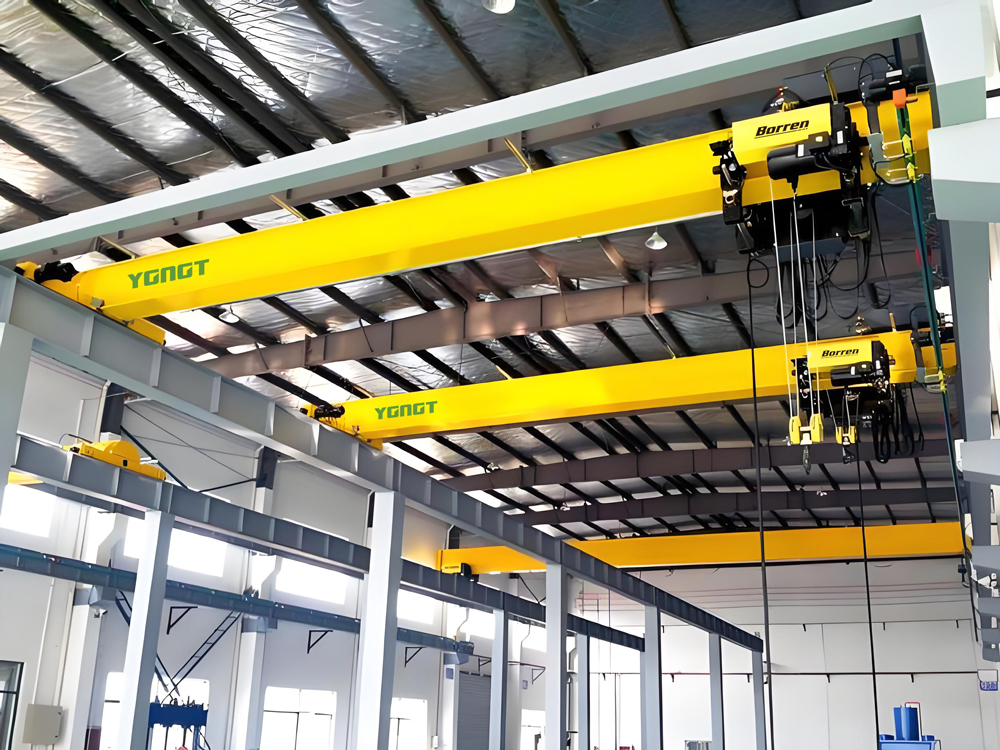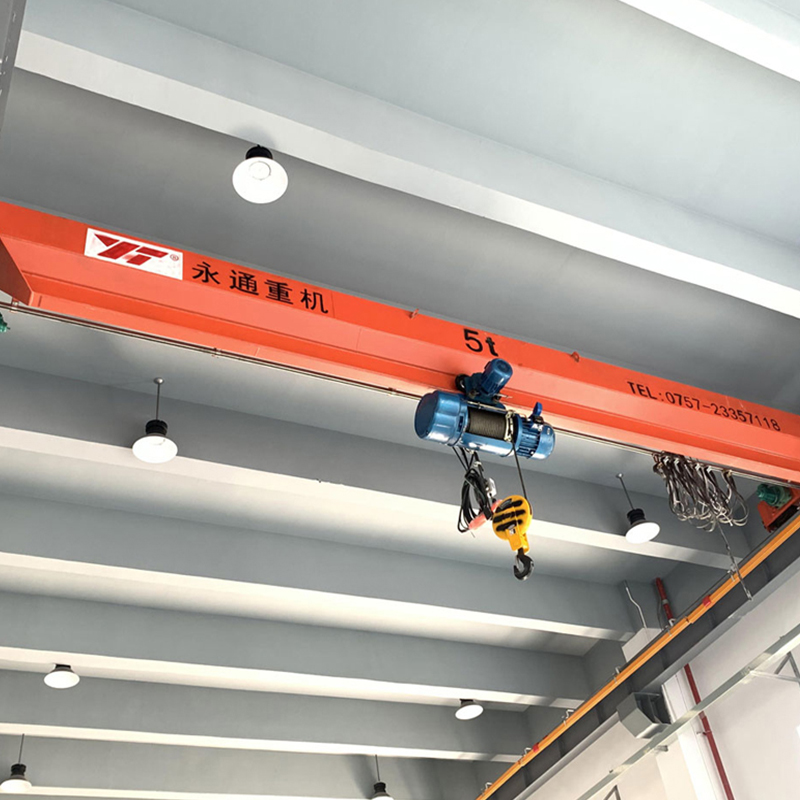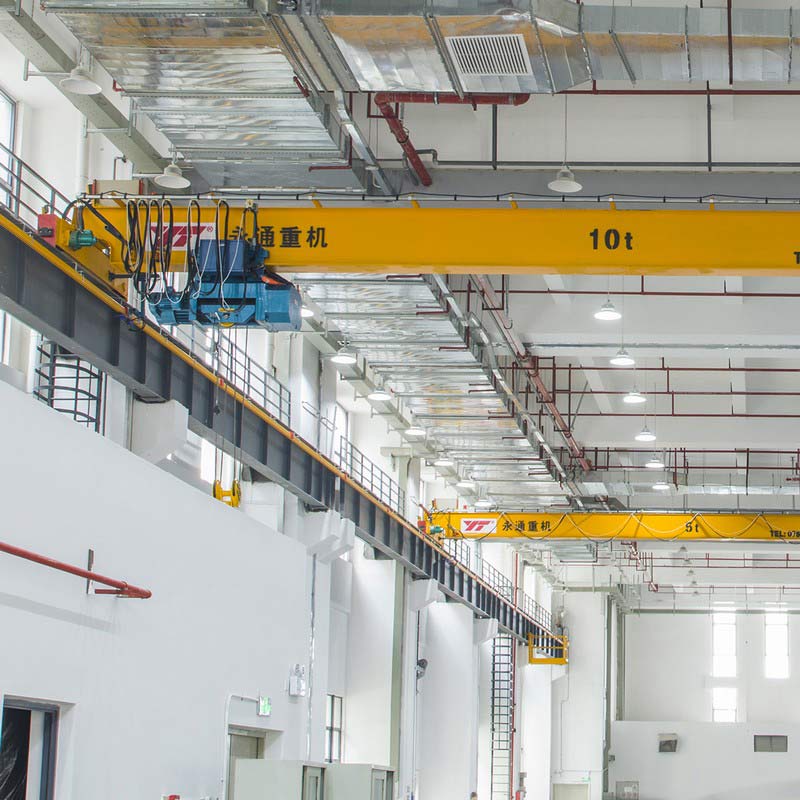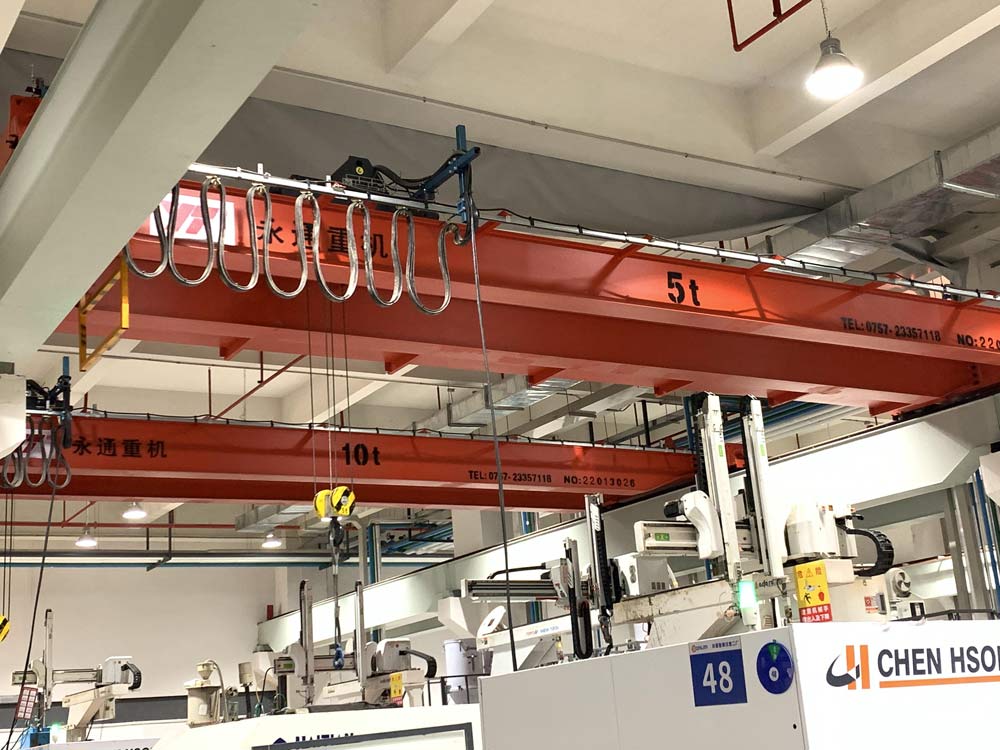Types & Application Scenarios
Understanding the different types of 5-ton overhead cranes and their suitable applications is the first step to a precise selection.
Single Girder Overhead Crane (e.g., LD-Type):
Features: Simple structure, lower cost, easy installation.
Applications: Standard workshops with sufficient vertical clearance for the girder and hoist. Widely used in machining, assembly, equipment repair, warehouses.
Note: Low Headroom (LDC-Type) models save vertical space by positioning the hoist beside or off the girder, ideal for height-limited workshops or retrofits.
Double Girder Overhead Crane (e.g., LH-Type, QD-Type):
LH-Type: Often uses an electric hoist, suitable for medium-duty applications like machine shops, assembly shops, metalworking, repair shops, warehouses.
QD-Type: Uses a trolley with a wire rope hoist (winding mechanism), designed for heavy loads and frequent operation, e.g., steel plants, mining.
Features: Two main girders, two end trucks, and a hoist trolley. Generally offers better load capacity, efficiency, and service life than single girder cranes.
Applications: Workshops, warehouses, stockyards, assembly lines. Compared to 5t single girder, 5t double girder is better for heavier duty and has higher requirements for runway support systems.
Subtypes:
European Overhead Crane / FEM Standard Crane:
Features: Designed per European FEM standards. Often uses modular "3-in-1" drives (motor, brake, gearbox integrated), compact structure, smooth start/stop, light weight, high rigidity, energy-efficient, low noise & maintenance. Often features frequency control (VF) for smooth operation.
Applications: Widely used in machinery manufacturing, petroleum, ports, railways, food processing, paper, electronics. Ideal for precise positioning and assembly of large components.
Explosion-Proof Overhead Crane:
Features: All motors and electrical components are explosion-proof (e.g., ExdⅡBT4 or ExdⅡCT4 rating).
Applications: Designed for flammable/explosive atmospheres, e.g., oil extraction/refining, natural gas processing, chemical storage, also flour mills, cement plants (dust), high-temperature workshops, chemical plants.
Special Application Cranes:
Metallurgical Cranes: For molten metal handling. Feature protective measures under the girder (insulation), high duty class (A6+).
Grab/Bucket Cranes: Use a grab for bulk materials (stacking, transfer, loading/unloading). For power plants, stockyards, terminals.
Electromagnetic Cranes: Use a lifting magnet for magnetic materials like steel.
Duty Class (ISO/FEM)
The crane duty class (A1-A8) reflects the intensity of use (load spectrum and average number of cycles). Choosing the right class is crucial.
A3 (Infrequent, medium loads): e.g., Some single girder cranes (standard LD, low headroom). For infrequent use: repair shops, light assembly, warehouses (2-3 hours daily usage).
A4 (Fairly frequent, medium loads): e.g., LH double girder cranes can reach A4. For moderate usage frequency.
A5 (Frequent, heavier loads): e.g., FEM standard single girder, European double girder, QD double girder cranes can reach A5. For frequent use: busy production/assembly lines (6-8+ hours daily).
A6 (Very frequent, high loads): e.g., QD double girder, metallurgical, grab cranes. For very frequent, heavy-duty use: metallurgy, foundries, mining.
Simply put: For general use, A3 or A4 may suffice. For continuous high-intensity work, you must choose an A5 or A6 class crane.
Price Range
The price of a 5-ton overhead crane is highly influenced by type, span, lift height, duty class, and configuration.
Approximate price references (Note: Always get quotes from suppliers for actual pricing):
| Type | Approx. Price Range (USD) | Approx. Price Range (CNY, ref ~1:7) | Main Influencing Factors |
|---|---|---|---|
| 5t Single Girder Crane | $2,400 - $29,000+ | ¥17k - ¥200k+ | Span, Lift Height, Hoist Type (Standard vs Low Headroom), Duty Class |
| 5t Double Girder Crane | $12,200 - $81,000+ | ¥85k - ¥550k+ | Span, Lift Height, Trolley Type (Hoist vs Winding), Duty Class, Drive & Control Config (e.g., VF) |
| 5t European Crane | $5,900 - $70,000+ | ¥41k - ¥490k+ | Span, Lift Height, Configuration (VF control, remote), Modularity |
| 5t Explosion-Proof Crane | - (Significant Premium) | - (Significant Premium) | Explosion-proof Rating (IIB vs IIC), Material Requirements, Certification Standards |
| 5t Metallurgical Crane | - (Significant Premium) | - (Significant Premium) | High-Temp Design, Insulation Measures, Duty Class (typically A6), Safety Requirements |
Other Key Price Factors:
Lifting Capacity & Span: Larger spans or specialized designs significantly increase cost.
Hoist Type: Standard CD/MD electric chain hoists are lower cost, European-style wire rope hoists or open winch hoists are higher cost.
Operating Environment: Explosion-proof, corrosion-resistant coatings, or high-temperature/humidity requirements add cost.
Control System Configuration: Variable Frequency drives, wireless remote, smart monitoring increase the overall price.
4. Selection Steps & Advice
Define Requirements:
Lift What: Material type (general, explosive, molten metal, bulk), max weight (include rigging!), size/shape.
Where Used: Workshop area, headroom height, runway support (existing support columns or悬挂from roof?), environment (explosive gas/dust, high temp, corrosion).
How Used: Expected daily usage time, workload intensity (lifts per hour), required precision for movement/positioning.
Budget: Initial investment budget and consideration for future operating/maintenance costs.
Determine Key Parameters:
Rated Capacity: 5 tons (remember rigging weight!).
Span (S): Distance between runway rail centers. Determined by workshop width.
Lift Height (H): Vertical distance from hook center highest to lowest point. Determined by equipment height, max workpiece height, required safety clearance.
Duty Class (A3-A6): Choose based on usage frequency and load spectrum.
Operating Speeds: Hoisting, long travel (crane), cross travel (trolley). Choose based on efficiency needs. Consider VF drives for frequent starts/precise positioning.
Control Method: Pendant, wireless remote, cab control. Remote offers flexibility and good visibility; cab is suited for large spans, long travel, or complex environments.
Select Suppliers & Get Quotes:
Choose qualified, reputable manufacturers/suppliers with reliable after-sales service.
Provide clear requirements and technical parameters, request detailed technical proposals and configuration lists.
Compare proposals carefully, focus on key components (girder structure, electrical component brands, motor brands, protection IP, safety devices).
Obtain formal quotes, clarify what's included (transport, installation, commissioning, training, taxes).
Focus on Safety & Compliance:
Ensure crane design/manufacturing complies with relevant national standards (e.g., GB/T 3811, GB 6067.1 in China) or international standards (FEM, DIN, CMAA).
Cranes for special environments (explosion-proof) must have corresponding certifications.
Equipment must be inspected and approved by special equipment inspection机构 before use after installation.
Consider Installation & After-Sales:
Confirm if the supplier provides installation and if the workshop's civil conditions meet requirements (e.g., rail installation).
Understand the supplier's after-sales response time, spare parts availability, maintenance capabilities.
Summary
Selecting a 5-ton overhead crane is about finding the most suitable, not necessarily the absolute best.
If your workshop headroom is limited and usage is not very frequent, a Low Headroom Single Girder Crane (LDC-Type, A3) might be economical and practical.
If your production pace is fast, usage is frequent, and you require stability and reliability, then a European Crane (FEM Standard, A5) or Double Girder Crane (A5), though potentially a higher initial investment, may offer better returns long-term through efficiency, stability, and lower maintenance costs.
If your environment involves flammables/explosives, you have no choice but to invest in an Explosion-Proof Crane.
If you're lifting molten steel, it must be a dedicated Metallurgical Crane (A6).




